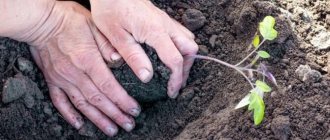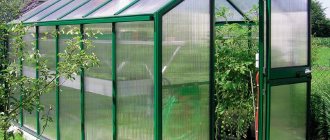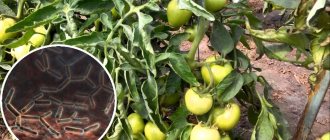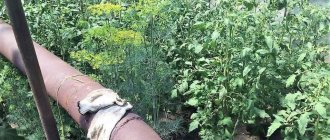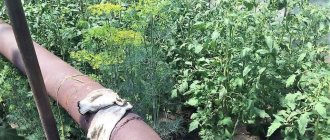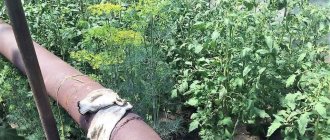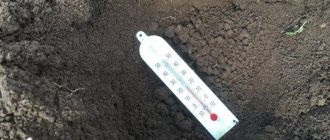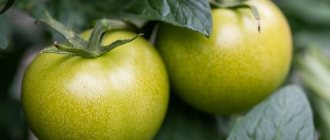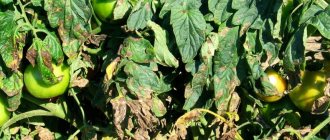Vegetable growing » Tomatoes
1
1405
Article rating
Kira Stoletova
Tomatoes are the most heat-loving crop, so their maintenance requires special conditions. The greenhouse allows you to establish a Mediterranean climate on the site. The temperature in a tomato greenhouse must be at a certain level so that the crop can produce maximum yield.
Temperature for tomatoes in a greenhouse
Permissible temperature for planting
The most important factor when planting tomatoes is the optimal soil temperature. It is measured shallow from the surface.
Before planting, make sure that the temperature for growing tomatoes in the greenhouse reaches at least 15ºC. To prevent rotting of the roots, the soil temperature should be at least 10ºC.
To effectively warm the earth, the film greenhouse is covered in advance.
If seedlings are planted before optimal conditions have been established, a little hot water is poured into each hole.
Preparing soil in a greenhouse
The bacterial cocktail contains many useful substances. Their function is to process nitrogen. The soil will be saturated, so the tomato yield will be higher.
One ampoule will be enough for 650 sq. m. You can buy the solution at any chain of stores for gardeners. Rules for using the drug:
- 1. Dissolve an ampoule of the substance in 2 liters of boiled water.
- 2. Add 1 tbsp. a spoonful of melted honey.
- 3. Pour the mixture into a jar.
- 4. Leave in a warm room for 2–3 months.
- 5. Stir 1 cup of the mixture in 20 liters of water and pour over the greenhouse evenly.
- 6. A few weeks before planting, water the soil again with this cocktail.
Mineral elements and organic fertilizers, together with abundant sunlight, give the soil beneficial properties, which leads to normal growth of the fetus and improved health.
If you can’t buy it, you can make a soil mixture at home. Instructions:
- 1. Having collected the entire harvest, remove all remaining greenery.
- 2. It is necessary to free the soil from roots. Carefully dig up the soil in the greenhouse.
- 3. You can destroy all possible pathogens using bleach and water (in a ratio of 1:33). After 3 hours, disinfect the wooden and metal parts of the greenhouse structure. Spread the bleach onto the ground with a rake.
- 4. In spring, it is better to apply horse or sheep manure. Biofuel must be distributed throughout the plantation in a layer of 30–40 cm and covered with earth.
- 5. Water the formed beds with warm water. 2 weeks before planting, it is recommended to fertilize the soil with ammonium nitrate.
Green soil slows down and impairs plant growth, so the following series of actions must be taken:
- 1. Stop watering for a while.
- 2. Define the problem. When moss appears, give light and fresh air to the soil, algae - close the greenhouse from the sun's rays.
- 3. It is recommended to lay sand and sawdust in several layers on the algae.
- 4. The affected layer of soil must be removed.
- 5. Ventilate the greenhouse room.
There are several levels of soil acidity. It is necessary to determine its level:
- in the laboratory of agrochemistry;
- using litmus paper;
- device for measuring soil parameters;
- the traditional way (boil currant leaves, throw in a little earth from the ground, the color will indicate oxidation, red is sour, green is not, blue is half sour).
Having determined the level, you should deoxidize the soil: with peat or wood ash, crushed chalk, lime or dolomite flour.
Replace the top layer of soil only as a last resort. The procedure is long, but the result is effective. Correct removal of the soil layer:
- 1. Dig out a layer of soil to a depth of 30 cm.
- 2. Cover with lime.
- 3. After a day, extinguish the lime with water.
- 4. After 3–5 days, lay a new layer of soil.
If even novice vegetable growers are familiar with applying fertilizers, and the suitability of a particular product for tomatoes grown in a greenhouse is described in detail in the instructions, then not everyone is familiar with soil disinfection. And clean soil is no less important for tomatoes than rich soil. They will not work to their full potential on problematic soil, so you need to know and follow several rules, and also know how much humus to add - this will help the normal growth of tomatoes and a good harvest.
But you have to be careful: copper is toxic. Its effect on the human body is negative
Gloves are required, closed shoes, feet and long sleeves will protect against possible contact of copper sulfate solution with the body.
Good predecessors for tomato: cabbage, cucumbers, carrots, onions, legumes
It is not recommended to plant tomatoes after crops of the Solanaceae family: potatoes, eggplant, peppers and, please note, tomatoes. That is why the place where tomatoes are planted needs to be changed every season, returning the vegetables to their original bed no earlier than after 3-4 years
- sanding (carried out in the fall for heavy, wet soil at the rate of 1 bucket of sand per 1 sq.m);
- liming (used to reduce soil acidity; for this purpose, during autumn or spring digging, lime powder is added to the soil at the rate of 0.5-0.8 kg per 1 sq.m);
- disinfection (in the spring the soil is treated with a hot (70-80⁰C) solution of copper sulfate at the rate of 1 liter per 1 sq.m);
- application of organic fertilizers (when digging the soil, add humus or rotted compost at the rate of 3-7 kg per 1 sq.m);
- application of mineral fertilizers is carried out during spring digging of the soil to a depth of 15-20 cm (see table).
| Consumption of mineral fertilizers per 1 sq.m | |
| Ammonium nitrate | 20 g |
| Superphosphate | 50-60 g |
| Potassium sulfate | 15-20 g |
Temperature conditions for growing
Tomatoes cannot tolerate even slight cold, so to grow tomatoes in a polycarbonate greenhouse, the temperature is controlled. These delicate plants are extremely strict in maintaining a rational temperature at every step of their development.
The influence of temperature on growing tomatoes:
- below 0.5°C - tomatoes die immediately;
- below 5°C - tomatoes are damaged and then lost;
- 15°C - vegetables begin to grow, but require a further increase in temperature;
- below 15°C - minerals are not absorbed so quickly and efficiently, roots develop slowly, access to water becomes difficult, and they take root less well;
- 10°C - roots stop absorbing nutrients from the soil and stop growing;
- from 25°C to 30°C are comfortable conditions for the development of culture.
The optimal daytime temperature in a greenhouse for tomatoes is considered to be from 21°C to 23°C, and at night - from 17°C to 18°C. For tomatoes, this is the best climate they can withstand. They better absorb minerals, moisture, and nutrients from the soil, which has a positive effect on the quality of the fruit.
An important factor is air humidity.
If it becomes cooler after planting the seedlings, the greenhouse is additionally heated artificially.
Automatic regulation
A lot of attention and time is paid to maintaining temperature and air exchange in tomato farming. It is difficult to manually regulate even a small country greenhouse; the weather changes rapidly during the day and you need to live close to the greenhouse, but this is not always possible. Therefore, many gardeners install automatic control. The mechanisms by which the “opening and closing” of transoms occur are:
- volatile, that is, they operate on mains electricity;
- autonomous, operating on the principle of air heating.
Automatic devices are more expensive than autonomous ones, but at the same time they respond more quickly to changes in weather conditions, are equipped with a timer and allow you to set a mode once and stick to it for a long time. If there are several greenhouses or a whole greenhouse farm, then you cannot do without an automatic mechanism for regulating the air temperature inside.
Minimum temperature threshold
The minimum temperature for growing tomatoes in a greenhouse depends on the plant variety. The average is from 5°C to 7°C. There are special frost-resistant varieties that can withstand sub-zero temperatures for a short time.
Frost resistance depends on the plant variety
To harden off tomatoes before planting, place the seedlings outside in the sun for a short time. This increases the resistance of plants.
Air temperature requirements
In order for seedlings to grow viable, certain temperature conditions are created for them corresponding to the stage of development.
When planting seeds
The seeds are germinated before sowing. This procedure increases their germination rate. Planting material is germinated at temperatures from 25 to 30 °C. At lower values, seeds will germinate much more slowly.
To ensure optimal temperature conditions, germinated seeds are placed on a radiator. It is important to promptly moisten the fabric in which the planting material is wrapped.
When the seeds are sown in the ground, the temperature in the room is maintained at 24 to 26 °C.
How to ensure the required conditions:
- Cover the box with the seeds with film.
- Place foam under the bottom of the box.
- Windows should provide maximum light, so boxes with crops should be placed on the south side.
After germination
When seedlings appear in the seedling boxes, the temperature is adjusted in such a way as to grow the strongest seedlings.
Temperature conditions after germination:
- First week. Maintaining low temperatures during the first week after germination helps prevent sprouts from stretching. Recommended temperatures:
- daytime – from 13 to 18 °C;
- night – from 11 to 14 °C.
- Second week. The temperature is gradually increased. Recommended values:
- on clear days – from 20 to 23 °C;
- in cloudy weather – from 18 to 20 °C;
- night – from 17 to 19 °C.
Many experienced gardeners adhere to other rules; they believe that temperatures should be lower:
- in cloudy weather – from 16 to 19 °C;
- at night – from 10 to 13°C.
A slight drop in temperature can provoke:
- weakening of the root system;
- developmental delay, which will negatively affect productivity.
Overheating has an equally detrimental effect on the development of seedlings. The sprouts stretch out, their stems become thin and weak.
At this stage, daylight hours should be at least 10 hours. If there is not enough light, turn on the lamps. The soil is moistened with a spray bottle, avoiding stagnation of water.
After the pick
If the seeds were sown in a common container, the seedlings have to be picked - planted in separate 0.5 liter glasses.
Recommended temperatures after picking:
- on clear days – from 20 to 23 °C;
- in cloudy weather – from 16 to 18 °C;
- night – from 12 to 15 °C.
Regulating the temperature in the greenhouse
The temperature in the greenhouse for tomatoes should differ from the air outside by 3°C-4°C.
Artificially increasing the temperature in a greenhouse
To increase the temperature in the greenhouse at night, additional layers of film are used, attaching them with fasteners. This action creates an air cushion that separates the greenhouse environment from the outside air. The side walls of the greenhouse are protected with foam film.
The additional base of a low greenhouse will be able to limit the amount of air above the plants. It is made from wood vine twigs or 2-3 mm wire, and the coating is made of perforated or whole film up to 0.5 mm wide.
The greenhouse is ventilated, and on sunny days the frame is removed completely or raised high so as not to create drought under it or increase humidity. The soil is covered with a narrow black film.
Reducing the temperature in the greenhouse
To lower the temperature, polycarbonate greenhouses cannot be made long. They are given open air access through the fronts. Spending on equipment will increase, but on hot sunny days the temperature will drop by 10°C.
The outside of the film can be sprayed with a solution of flour, chalk or clay. To do this, take 2 kg of product per 10 liters of water and 0.4 liters of milk. Quicklime cannot be used: it makes the film dull.
In the morning, the plants are watered with sufficient water. They use special white shields. They do not transmit infrared radiation and are resistant to rain.
Temperature sensor
Using the sensor, it is possible to find the most correct mode for crop growth. Growing temperatures range from 16°-25°C during the day to 12°-19°C at night.
The soil temperature should always be 14°-25°C.
Optimal microclimate for high yields: temperature for tomatoes
Tomatoes are heat-loving tropical inhabitants. When growing them, it is necessary to observe temperature parameters. The plants will die from the cold; in extreme heat they will not be able to set fruit, since the pollen will be sterile.
Optimal temperature
At each stage of development, a tomato plant needs different temperatures. Seeds can be stored even in the cold, but they will only be able to germinate if the thermometer shows above +15.
Shoots appear most quickly at +20... +30. Immediately after the cotyledon leaves are brought to the surface of the soil, coolness is needed. When the thermometer shows +14… +16, the roots of tomato plants begin to grow intensively, and the elongation of the above-ground part stops. A temporary decrease in degrees allows you to obtain strong, stocky seedlings with a well-developed root system, even with a lack of light.
Further development of seedlings should occur at +20...+22 during the day, and +16...+18 at night. Night reductions are required to prevent plants from stretching out in the dark.
Critical, minimum and maximum temperatures for tomatoes:
- +10 – the growth of the above-ground part stops, the roots stop absorbing, which is why signs of nutritional deficiency appear on the leaves;
- +8 – the plant begins to die;
- +12 – the ovaries fall off, the finger does not ripen;
- +30 – pollen becomes sterile;
- +43 – plants die;
- +0.5 – instant death.
It is especially important to monitor the temperature in the greenhouse. The comfortable temperature for tomatoes in protected soil is +25… +28 degrees. With high humidity in greenhouse air, heat does not cause oppression of plants, but, on the contrary, helps create “tropical” conditions that are natural for nightshades.
Temperature in a tomato greenhouse at night and during the day
Due to their heat-loving nature, most varieties of tomatoes are grown in our country in shelters: polycarbonate, film and glass. During the day, the temperature in the building should be in the range of +15... +25, and at night it should drop by 5-8 degrees. Being at the lower limit of normal, the temperature will slow down growth and ripening, which is necessary when tomatoes stretch too quickly. At high temperatures, the green mass grows quickly, which may affect the yield and quality of the fruit.
What does it affect?
Temperature affects all processes occurring in a tomato plant - from photosynthesis to respiration. By changing the temperature, you can influence the rate of growth and development, slowing down or speeding up fruiting, which is used in the industrial cultivation of tomatoes.
For the timing of planting tomato seedlings in open ground, it is important how warm the soil is. Its temperature should not be lower than +15. If it is not possible to measure the indicator with a thermometer, experienced summer residents proceed as follows: plant seedlings no earlier than the apple tree blooms. Many years of practice have established that an apple tree blooms when the soil in a layer of 40 cm warms up to no less than +15.
How does demotion work?
Summer residents can independently increase the frost resistance of plants by hardening them at the seed germination stage. During freezing, seedlings in the ground can be covered with caps made of paper, fabric or cut plastic bottles. The traditional way to cover adult plants is to throw a film or agrotex over the arches.
Care when lowering
If weather forecasters promise a sharp cold snap, the plants urgently need to be fed with potassium. It increases cold resistance, making the cell sap more viscous, which prevents it from freezing. Adaptogen drugs, especially Epin, help cope with cold weather. Before or immediately after freezing, plants are sprayed with this stimulant and they feel more comfortable.
How to increase cold resistance
The swollen seeds are hardened in the refrigerator at a temperature of 0…+2. The technique is called freezing. After it, the plants become more hardened, bloom earlier, and germinate faster. Freezing increases resistance to fluctuations in day and night temperatures.
Drugs that increase cold resistance:
- Baikal EM,
- Sodium and potassium humate,
- Gibbersib,
- Immunocytophyte,
- Amulet,
- Zircon,
- Ecosil,
- Epin.
Any of them is diluted with water according to the instructions on the package and sprayed on tomato plants according to the scheme proposed by the manufacturers of the product.
Proper care of tomatoes
Most subspecies of tomatoes produce good yields both with long and short daylight hours. To obtain the desired number of fruits, it is necessary to increase the light intensity. When there is insufficient light, crop growth is disrupted; its deficiency increases the ripening time by 1-2 weeks. Bad weather conditions negatively affect the quality and taste of fruits.
Favorable temperature for tomato growth is an important indicator, but with improper irrigation it begins to play a secondary role. Plants are considered conditionally moisture-resistant, with an average water requirement. The frequency of soil moistening and the volume of liquid depend on the general condition of the plantings, the specific characteristics of the soil and the influence of solar radiation.
In enclosed spaces, soil moistening is carried out in the morning, up to 2 times a week, preferably in warm weather. When grown outdoors, it is performed in the evenings, from 7 to 9 o'clock. The water used for procedures is warm, about 20 degrees.
In addition to the temperature for tomatoes, air humidity has a great influence on the condition of the plants. Recommended indicators are within 60-70%. When they increase to 80-90%, pollen sticks together and the risk of developing bacterial and fungal infections increases. Reduced rates lead to the absence of ovaries.
Watering tomatoes plays an important role
Weeding
Top dressing
Feeding tomatoes
Disease Control
The influence of different temperatures on seedlings
At high temperatures, tomatoes quickly begin to bloom and bear fruit, but because of this, the number of fruits in the future will be much smaller. When the seedlings are placed in a place where the temperature is lower than optimal, the growth of the plant is significantly slowed down, but the result is a very good harvest.
If it differs greatly from the required parameters, the tomato bears fruit much later and rather poorly. These tomatoes have a significantly lower level of sugar and fruit acids.
Sudden temperature changes can negatively affect crop growth. When the thermometer drops to +5 °C, the plant stops developing.
Minimum
It is important to ensure that the place where the seedlings are located has an optimal thermal regime. The mark on the thermometer should not reach +10 °C, otherwise the growth of the plant will stop. Tomatoes love heat very much, so it is recommended that the minimum value be +12 °C at night and +23 °C during the day.
Maximum
The temperature at which seedling growth stops is above 28 °C and below 13 °C. In this case, the plant's pollen is sterilized.
When to water?
When and how often to water tomatoes in a greenhouse? Gardeners do not have a unanimous opinion on this issue, but it is still recommended to focus on weather conditions and the structural features of your greenhouse.
If the weather outside is warm and dry, then watering time does not matter. Especially if you do it carefully and the possibility of sunburn of the leaves is excluded. It is better to water in the afternoon, since the water is already quite warm by this hour, whereas in the morning it is still cool.
Watering late in the evening is also not recommended. Because a greenhouse closed at night creates excess air humidity, and this is harmful for tomatoes.
If watering is carried out in the evening, long-term ventilation of the greenhouse is required after it, so that excess moisture evaporates and the tomatoes remain healthy.
In damp and cool weather, it is better to water the tomatoes before noon, so that the space is well ventilated during the day and excess moisture evaporates from the air.
IMPORTANT. No matter what time you perform the procedure
Leave the windows and doors open after it. If you close the greenhouse immediately after watering, the excess moisture in the air will encourage the development of fungus.
Proper organization of watering tomatoes when growing them in a greenhouse will allow you to get a large harvest of healthy and tasty fruits.
Soil acidity
At what acidity and temperature do tomatoes grow: the level refers to important criteria that are presented when growing a crop. The normal value is within the range of 6-6.8 pH, such figures are not accidental - many years of practice and the work of breeders have proven that the conditions are suitable for the normal growth and development of plants.
| Land type | pH indicators |
| Neutral | from 5.5 to 7.0 |
| Strongly acidic | 4,5 |
| Sour | from 4.5 to 5.0 |
| Subacid | from 5.0 to 5.5 |
The best choice for tomato plantings is soil with neutral indicators. If acidity is high, preliminary work is carried out to help reduce it. To do this, lime is added to the soil; during the procedure, the following conditions must be observed:
- the process is scheduled for the spring, before transplanting seedlings, or in the fall, after harvesting;
- crushed lime mixture is used for work;
- all work is carried out in clear weather without wind;
- a thin layer of lime is scattered over the entire area, without gaps.
What equipment is used for growing tomatoes?
To additionally heat the greenhouse in which vegetables are grown, a type of heater such as paraffin is often used. It allows you to quickly increase the air temperature in the room. Paraffin heaters are effective; another undeniable advantage is that they are safe for plantings.
Specific paraffin heaters perform two functions: in addition to heating the room, they also humidify the air in it. But when installing such devices, you should control thermoregulation and cravings.
Spunbond is also important, thanks to it, moisture and heat are retained in the soil for a long time. In addition to using spunbond, the soil can also be heated using equipped electrical cables. They are dug into the soil before planting seedlings no more than 20 centimeters.
The cable is protected by a special steel mesh. To increase thermal conductivity, the wires are laid on sand, they are also sprinkled with sand on top, only then they are laid in the soil and watered - wet soil will heat up much faster. Proper construction is also important in maintaining optimal temperature. No cracks or gaps between doors or windows are allowed.
The optimal temperature for such a vegetable crop is 25 degrees Celsius. Thanks to proper care, vegetables will develop normally and subsequently bear good fruit. And, of course, do not forget to use spunbond.
Classification of plants depending on temperature requirements
Crops grown in a greenhouse, depending on temperature requirements, can be divided into several groups:
- Cold-resistant - crops that are resistant to low temperatures. These include spinach, various types of cabbage: Brussels sprouts, cabbage, Savoy, kohlrabi and others. Seeds of these crops germinate best at t°+ 20-22°C, and seedlings develop if the temperature in the greenhouse is maintained at +14-15°C ± 3° depending on the weather - sunny or cloudy, at night is acceptable temperature reduction to +6-10°C.
- Moderately thermophilic - crops that develop well in a greenhouse at temperatures up to +16-17°C ± 2° correction for cloudy or sunny weather. This group includes various varieties of lettuce and onions, celery, chard, and beets.
- Heat-loving crops, the development of which requires the creation of a temperature in the greenhouse of about +20°C ± 4°, adjusted for weather. At night, it is permissible to reduce the temperature to +12°C. Representatives of this group are tomatoes, eggplants, peppers, cucumbers and other pumpkin crops; their seeds germinate better if the temperature in the greenhouse is kept at +25-28°C.
Attention! When planning to grow vegetable seedlings in a greenhouse, it is recommended to select crops with similar microclimate requirements.
Tomatoes require a temperature of about 20 degrees
Planting seedlings in the ground
It is permissible to plant tomatoes in heated greenhouses with good thermal insulation in late April - early May. In unheated, but additionally insulated - in the first weeks of May. In cold weather - from mid-May. Planting is carried out if the air temperature is maintained at least 20-25 °C, and in the soil at a depth of 15-20 cm - at least 12-13 °C.
Soil preparation
It is better to prepare the soil for planting tomatoes in a greenhouse or greenhouse in the fall. It is preferable to grow the crop in soils with normal acidity (pH 6.5-7). To improve fertility on loamy or clay soils per square meter. per meter of plantation is filled with a bucket of humus and turf. For loosening, add a bucket of sawdust and half a bucket of coarse sand.
Also in the fall, the soil is enriched with minerals:
- 1.5-2 cups of wood ash;
- 2-3 tbsp. spoons of Superphosphate;
- Art. a spoonful of potassium sulfate;
- a teaspoon of urea.
Over the winter, fertilizers will dissolve and will be more easily absorbed by plants. The soil with additives is carefully dug up and ridges 20-30 cm high or holes 15 cm deep are prepared. If desired, you can fill the holes prepared for planting with ready-made purchased soil based on turf or humus at the rate of 3-4 kg per square meter. meter.
Planting scheme
On each side of the central aisle of a greenhouse, two rows of plantings are usually arranged, taking into account the growth characteristics of different varieties:
- Low-growing (standard) quickly ripening varieties, bushing into two or three stems, are planted in a checkerboard pattern. Leave 35-40 cm between bushes, the interval between rows is 50-55 cm.
- Medium-sized species are planted at intervals of 20 cm in rows, and 45-50 cm between rows.
- Giant (indeterminate) varieties are also recommended to be planted in a checkerboard pattern. The interval in the row is 55-60 cm, row spacing is 75-80 cm.
When breeding different varieties of tomatoes, it makes sense to use a universal scheme, where all the bushes are formed into one stem:
- In the row closest to the walls of the greenhouse, early ripening determinate varieties are rooted.
- Tall tomatoes are planted in the row closest to the aisle. Dwarf standard species are planted with them at intervals of 25 cm.
The order of planting seedlings
The holes are spilled with a solution of potassium permanganate (1 g of powder per 10 liters of water) at the rate of 1-1.5 liters for each. Tomato bushes are rooted in soil slurry with a lump of earth from a container or together with peat pots.
Tomato bushes are planted with inflorescences facing the aisle of the greenhouse. This way the fruits will be less shaded by the foliage, making artificial pollination easier.
After planting, the holes are sprinkled with soil and compacted around the root. The surface of the bed is mulched. Overgrown seedlings should not be laid on their side. It is better to deepen it further without filling the hole, and when the plants take root, fill the hole with soil.
The video shows planting tomato seedlings in a greenhouse. Filmed by the Gardener Newspaper channel.
What determines the quality of the crop?
Watering. Until the seedlings have taken root, you should refrain from watering. The first watering should be done approximately 10 days after planting. The water should have an average temperature of +20-23 degrees. After flowering begins, watering should be increased from 5 liters per 1 sq. meter to 10 liters.
Ventilation. Two hours after watering and at other times, the greenhouse should be ventilated by opening the windows or door and lifting the film. This should not be neglected, because temperature conditions are very important, especially during flowering.
Garter. Already on the third day after planting, you need to start tying. The procedure is carried out so that the stem of the plant does not break under its own weight, and the fruits do not rot.
Stepsonning. Stepchildren are the side shoots of a plant that grow not on the stem, but from the axils of the leaves. In this way, they branch the bush, which leads to shading, the spread of diseases and a reduction in the ripening period of the fruit.
Important! The pinching procedure is usually carried out in the morning to dry the wound.
Feeding. Without fertilizing, it is unlikely that you will be able to get a really large and juicy harvest. The first feeding is applied 10-15 days after planting, the second - after another 10 days. Ultimately, the procedure must be done four times during the season.
Planting in open ground
Different varieties of tomatoes can survive at different temperatures, but the general survival range of tomatoes is considered to be from 0⁰ to 43⁰. There are frost-resistant tomatoes that do not die in frosts down to -4⁰, but only in calm weather and for a very short time. If the nights are frosty, it is useless to plant them outside without shelter. What factors increase plant resistance to cold?
- Zoned varieties,
- low bushes with strong thick stems,
- well developed root system,
- adequate nutrition and proper watering,
- absence of diseases and pests,
- hardening
The heat requirements for seedlings growing from seeds directly in the garden are the same as for seedlings at home or in a greenhouse. Until the daytime temperature is about 23⁰, and the night temperature is not lower than 15⁰, the seedlings need to be protected from cold air. Don't forget that all the requirements for warm air and soil also apply to water.
The plant is basking in the sun, its roots are tenderly embraced by the loose warm earth, and suddenly the whole idyll is disrupted by an icy shower from a watering can. Such stress has a detrimental effect on all tomato systems. Do not mock your pets, keep the container with water in the sun, and when the liquid heats up above 20⁰, water it.
Seedlings grown on a windowsill and properly hardened can be planted in open ground if the minimum temperature at night is not lower than 10⁰. Don’t panic when you see 6⁰ on the thermometer; this is not lethal cold for tomatoes, but such coolness is undesirable for good plant development. Carefully monitor the forecast and cover your plantings in time.
We invite you to familiarize yourself with Large-fruited potato varieties
Conclusion. Tomato seedlings are a fairly hardy plant; temperatures that are destructive for them are below 0⁰ and above 43⁰. There is no need to subject plants to such extreme experiments; they can withstand critical values for a very short time. Much depends on the variety and condition of the seedlings. If strong, hardened tomatoes of varieties zoned for northern areas survive a slight frost, then delicate exotic tomatoes, accustomed to warmth, will die every single one.
At each stage of development, seedlings need their own optimal air temperature. The seeds should germinate in a cool place, then the seedlings should be moved to a warmer place, and when the first true leaves appear, the air temperature should be reduced again. Before planting in a greenhouse or open ground, it is advisable to harden the tomatoes so that sudden frosts do not destroy them.
Try not to deviate from the recommendations for the optimal temperature for growing tomatoes in a greenhouse, on a windowsill and outdoors. If you keep them in heat or cold all the time, the seedlings may survive, but they will weaken and begin to get sick. If the thermal conditions are incorrect, the leaves will develop too rapidly to the detriment of the ovaries.

